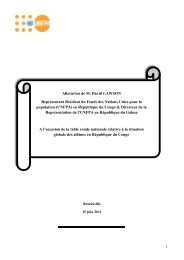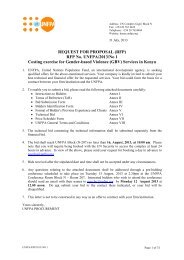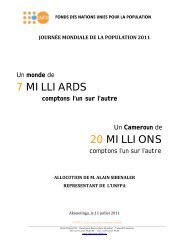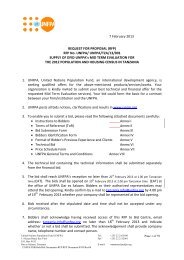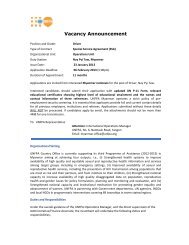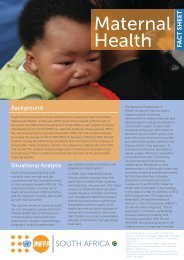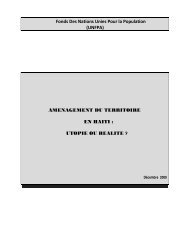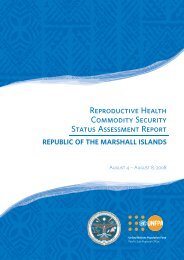A reproductive health needs assessment in Myanmar
A reproductive health needs assessment in Myanmar
A reproductive health needs assessment in Myanmar
Create successful ePaper yourself
Turn your PDF publications into a flip-book with our unique Google optimized e-Paper software.
A Reproductive Health Needs Assessment <strong>in</strong> <strong>Myanmar</strong><br />
AN APPROACH TO PROGRAMME DEVELOPMENT<br />
In develop<strong>in</strong>g a programme to provide the essential package of services to be delivered <strong>in</strong> an<br />
<strong>in</strong>tegrated manner, attention <strong>needs</strong> to be paid to vary<strong>in</strong>g epidemiology of <strong>reproductive</strong> <strong>health</strong><br />
problems <strong>in</strong> <strong>Myanmar</strong>, and the priority and feasibility of needed <strong>in</strong>terventions.<br />
The <strong>assessment</strong> team observed that all the services <strong>in</strong> the essential <strong>reproductive</strong> <strong>health</strong> care<br />
package - maternal <strong>health</strong>, birth spac<strong>in</strong>g, RTI/STD/HIV/AIDS and adolescent <strong>reproductive</strong><br />
<strong>health</strong> - need to be provided. However, secondary data as well as the team’s field visits<br />
showed that there were wide variations <strong>in</strong> the epidemiology of <strong>reproductive</strong> <strong>health</strong> problems.<br />
Although geography played a major role, other socio-economic and cultural factors also<br />
contribute to this variation. For <strong>in</strong>stance, many areas closer to Thai border had higher<br />
prevalence of STD/HIV/AIDS. Areas with higher socio-economic status and improved<br />
access to <strong>health</strong> facilities seem to have lower levels of maternal <strong>health</strong> problems. Use of birth<br />
spac<strong>in</strong>g methods, although <strong>in</strong>creas<strong>in</strong>g nearly everywhere, also varies widely depend<strong>in</strong>g on the<br />
social support for birth spac<strong>in</strong>g, availability of services and people’s ability to afford them.<br />
The young men <strong>in</strong> or those with access to urban areas are more likely to visit commercial sex<br />
workers and, therefore, are at higher risk of STDs/HIV <strong>in</strong>fections.<br />
A comprehensive set of <strong>in</strong>terventions was presented <strong>in</strong> the previous chapter to address<br />
specific <strong>reproductive</strong> <strong>health</strong> problems. After develop<strong>in</strong>g the set of recommended<br />
<strong>in</strong>terventions, the <strong>assessment</strong> team conducted an <strong>in</strong>formal prioritization exercise. Each<br />
member of the team rated each of the recommendations as high medium or low <strong>in</strong> terms of<br />
four criteria: potential for impact; policy congruence; organizational compatibility; and,<br />
operational viability. After giv<strong>in</strong>g these rat<strong>in</strong>gs a numerical value (3 for high, 2 for medium,<br />
and 1 for low), the scores for the four criteria were pooled and each team member’s score<br />
pooled. This produced an overall rat<strong>in</strong>g score for each recommendation, which were then<br />
reviewed by the <strong>assessment</strong> team.<br />
One of the most <strong>in</strong>terest<strong>in</strong>g f<strong>in</strong>d<strong>in</strong>gs of this exercise was that a number of the<br />
recommendations that had been rated very highly for their potential for impact fell to the<br />
bottom of the overall list once the four criteria were pooled. These <strong>in</strong>terventions were<br />
generally considered by the team to be extremely important <strong>in</strong> terms of impact, but that they<br />
would be difficult to implement because of the low level of policy congruence, organizational<br />
compatibility and operational viability. The most strik<strong>in</strong>g examples of this were <strong>in</strong> the area<br />
of STDs/RTIs. Condom promotion activities were jo<strong>in</strong>tly rated the highest priority (out of a<br />
total of 60 <strong>in</strong>tervention recommendations) for potential for impact. However, once the other<br />
three criteria were <strong>in</strong>cluded <strong>in</strong> the calculation, it fell to 50 th position. Similarly, a<br />
recommendation regard<strong>in</strong>g the need for targeted primary prevention <strong>in</strong>terventions such as<br />
peer education programmes for high risk groups, dropped from a rank of 19 to 56.<br />
Based on the vary<strong>in</strong>g epidemiology, and priority and feasibility of <strong>in</strong>terventions, it is clear<br />
that a uniform programme would not be an efficient way to address <strong>reproductive</strong> <strong>health</strong><br />
problems. An <strong>in</strong>cremental and cost-effective approach to programme development would<br />
comprise of implement<strong>in</strong>g (a) a core package of high priority <strong>in</strong>terventions everywhere, and<br />
(b) additional <strong>in</strong>terventions to address specific <strong>reproductive</strong> <strong>health</strong> problems <strong>in</strong> the<br />
geographic areas where the problem is serious as determ<strong>in</strong>ed by key <strong>in</strong>dicators of the<br />
criticality of the problem.<br />
85




